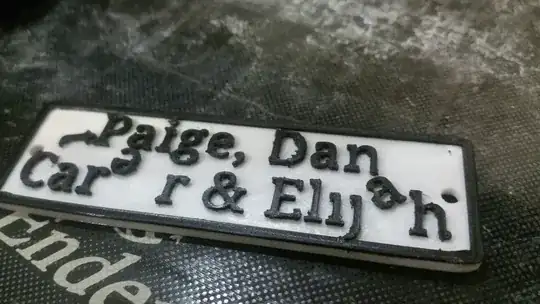I have been trying to make some small signs, and to highlight the text by changing between black and white filament at a layer just above where the text comes out of the back plate.
I've used Cura 4.12 and the "change filament" script to make the printer pause at the right layer. The change and purge process works fine, no issue there.
However the second colour adheres poorly to the first. Doesn't matter if I print Black then White, or White then Black. Both filaments are the same brand.
- Should I dab gluestick into the print at the same time as changing colour? (read on)
- Is there some way to re-preheat the object and get a better adhesion?
To save the print I've used superglue to stick the letters back on that have fallen off, but is definitely not ideal.
Here's an example:
The loose letters are held on well enough for printing, but only barely. They can knock loose at a touch of a finger afterward.
I have tried changing filament on the first layer that is not the back board, and one or two layers up the letters. One print I even changed filament a layer too low, and surprisingly that did not have adhesion problems. Perhaps it is merely a function of surface contact area ?
Gluestick on the exposed surface while changing filament was useless - the whole thing simply didn't stick and the second colour never got any adhesion at all, merely wiping off.
As for timing, it seems to make little difference if I'm there waiting for the last layer to print, or if I let the printer sit for half an hour before noticing and changing colour. The bed stays hot at 50 degrees, and the hot end is permitted to cool off.
There is a heating cycle, and then a purge/discharge-into-air that shows the transition between colours, so its not that the filament has lost a prime.
At the moment, a much more effective solution is to use a paint marker and colour-in the top layer with a contrasting colour.
